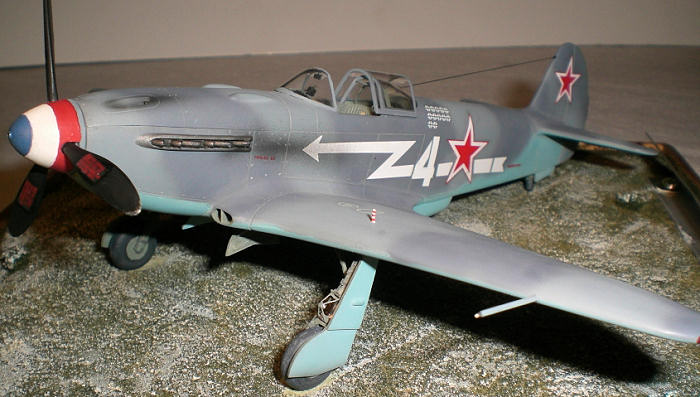
Eduard 1/48 Yak-3
| KIT #: | 8028 |
| PRICE: |
Around
20 Euros (from second hand market) |
| DECALS: | Four options |
| REVIEWER: | Patrick Grué |
| NOTES: | miscellaneous additional scratch parts added |

| HISTORY |
Undoubtedly the
Yak-3 was one of the most popular Russian propeller fighters during WWII. Its
success was not a legend among the pilots who had the chance to fly it. As said
test pilot Piotr Stefanovski about the Yak-3 “This is not an aircraft, this is
the dream of all fighters”. Its success was in fact due to a long outcome of the
previous versions Yak-1, Yak-7 and Yak-9. The Yak-3 should normally be ready
before the -7 but the innumerable improvements required by the Russian Aviation
Authorities – mainly in terms of weight and performances – delayed its
production until June 1944.
Its main features
were the plywood wings and stabilizers which gave this aircraft its legendary
maneuverability. The Klimov VK-105PF engine was powerful enough - with only
1,300 HP - to propel this light fighter at a top speed of 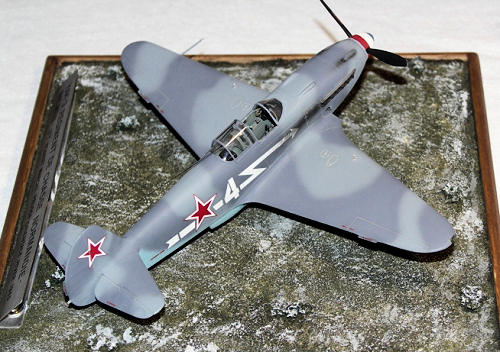 pilots.
However the advantage of a wooden construction was also a disadvantage. The
quality and reliability of glued-on plywood sheets was not as good as expected:
during the high rate of turn in combat phase the G force was such important that
some wood parts of the wings broke or unstuck which was often a lethal issue for
the pilot. To this end, some of the German pilots knew this flaw and the most
daring pilots took along the Yak-
pilots.
However the advantage of a wooden construction was also a disadvantage. The
quality and reliability of glued-on plywood sheets was not as good as expected:
during the high rate of turn in combat phase the G force was such important that
some wood parts of the wings broke or unstuck which was often a lethal issue for
the pilot. To this end, some of the German pilots knew this flaw and the most
daring pilots took along the Yak-
The French version selected by
Eduard is in fact the Yak-3 “white
Nowadays this
fabulous fighter is coming back among the airshows worldwide. Some pilots and
collectors rebuild the Yak-3 from original structural parts available in
museums. They fit their aircraft with an American V-1710 Allison engine instead
of the Russian Klimov engine which is no more airworthy since a long time. Some
of them have the original wooden wings; others are built all-aluminum. I saw one
of these warbirds at the Duxford airshow (
| THE KIT |
A particular
attention should be taken by modelers if they try to check the dimensions of
this model kit (which represents the Yak-3 fitted with VK-105 engine) with the
ones of a full scale flying replica. The flying replicas fitted with Allison
engines are similar to t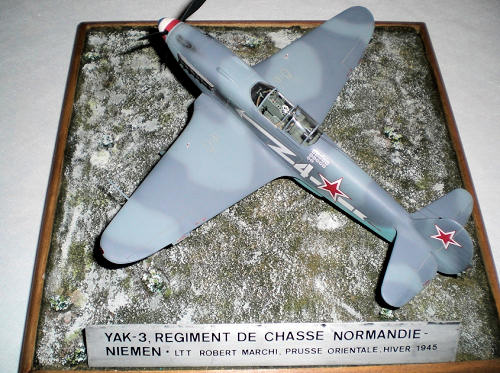 he
original post-war Yak-3 fitted with Klimov VK-107 engine with some minor
differences such as the air intake in front of the windshield. When compared to
the early versions (VK-105), the cockpit is shifted
he
original post-war Yak-3 fitted with Klimov VK-107 engine with some minor
differences such as the air intake in front of the windshield. When compared to
the early versions (VK-105), the cockpit is shifted
When opening the box this kit seems an easy model to build despite the very small photo-etched parts it includes. There are 51 parts in plastic including the two canopies (open or closed position) protected by bubble wrap, and 54 parts for the PE sheet. Option is given for two flattened wheels in resin. As usually in Eduard productions there is a film sheet for the instrument panel and a pre-cut sheet for the canopy masks. The decal sheet is nice and gives four marking options. The instruction sheet is clear but a tricky step may be avoided before gluing the cockpit consoles (see construction). Some photos in color of a flying replica are printed on a specific sheet for additional details about wheel well and air intake if needed. As only drawback I could say that the panel lines are a bit large but this is not important as this aircraft does not have many of these. The thickness of the wing trailing edge must also be reduced. However the main dimensions are accurate if compared with my paper sources.
| CONSTRUCTION |
I started as
usually with the cockpit at steps #1, 3 and 4. The real problem is the numerous
throttles and cocks in PE to glue onto the consoles. You need patience and skill
here. The seat belts are nicely drilled and give a realistic impression when
painted. Exhaust pipes must be drilled to be more realistic.
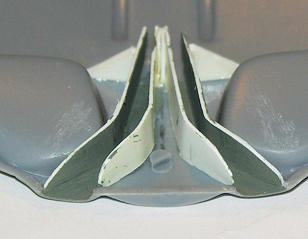 I modified
the air intakes at step #2 by adding interior details such as air ducts in sheet
styrene.
I modified
the air intakes at step #2 by adding interior details such as air ducts in sheet
styrene.
The step #5 suggests gluing LH and RH
consoles on the cockpit floor which is molded with the wing upper part. I advise
not doing that this way because the consoles could not fit correctly when the
fuselage halves will be glued on the wings; a g
Cockpit interior – as well as wheel
wells - was painted in grey-green using Humbrol 31 enamel with a final dry-brush
of silver powder to give a metallic aspect. The seat belts and rudder pedal
belts are painted in beige.
The instrument panel needs a sheet
styrene glued onto the rear side to reinforce it, and a white paper sheet within
the film and the PE pane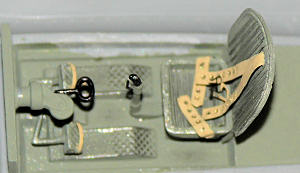 l
to lighten indicators and needles. In order to have the best fit between this
panel and the fuselage, I preferred gluing it onto a fuselage halve instead of
gluing it onto the consoles as indicated in step #6.
l
to lighten indicators and needles. In order to have the best fit between this
panel and the fuselage, I preferred gluing it onto a fuselage halve instead of
gluing it onto the consoles as indicated in step #6.
Then steps #7, 9 and 10
(wings, fuselage, stabilizers, propeller and canopy) come easily straight
forward. I chose to fit the elevators in down position; the cut out of these
parts is easy. I reworked the aileron and rudder tabs using m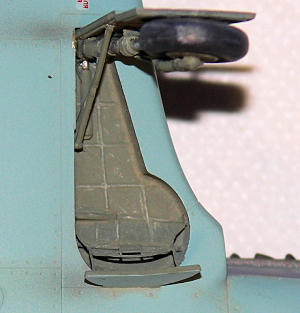 etallic
parts from the PE sheet to be more realistic. I glued the engine cover onto the
fuselage assembly in steps #7 instead of step #1 after including sting needles
for the two
etallic
parts from the PE sheet to be more realistic. I glued the engine cover onto the
fuselage assembly in steps #7 instead of step #1 after including sting needles
for the two
Step #8 – the last one for my
construction - is dedicated to the landing gear. You need also patience and
skill here because the brace struts of the legs and doors are made in PE and
they are fragile though.
I chose to display
the two air exhausts underneath the fuselage in open position as it is usually
the case when the aircraft is on ground. They are molded in closed position. If
doing this way, you need to build two little scoops in aluminum sheet.
As usually I added some parts not included in this kit such as the brake wires for the L/G legs, the two L/G position indicators (red/ white pins) on the wings and the antenna wire.
| COLORS & MARKINGS |
I started to paint
the lower surfaces in Russian “light blue” with my airbrush using enamels. To do
this I mixed 10 parts of Humbrol 65 light blue with 3 parts of Humbrol 89 middle
blue to reinforce the Russian “light blue”.
 The upper
surfaces were sprayed using Testor enamels. I started to spray the upper
surfaces with T-1721 medium grey, and then I mixed one part of T-1721 with one
part of T-1723 gunship grey for the camouflage schemes. The result gives two
shades of grey which match with the NASM original model.
The upper
surfaces were sprayed using Testor enamels. I started to spray the upper
surfaces with T-1721 medium grey, and then I mixed one part of T-1721 with one
part of T-1723 gunship grey for the camouflage schemes. The result gives two
shades of grey which match with the NASM original model.
The decals are
easy to apply but are a bit gloss. It is not a problem if over sprayed with a
matt varnish. However there is a small mistake with the two white arrows on the
fuselage sides. They must be lowered as regard of the red star.
As usually I
weathered my model with smoke and oil marks using a mixture of black/ brown
acrylic paints airbrushed. The panel lines were weathered using a mixture of
light grey and water, and the wheel wells were dry brushed with a lighter shade
of grey-green.
The model is displayed on a typical winter diorama which shows this aircraft when moving thru Northern Germany near the Baltic Sea in January/ February 1945. The frost was made using white acrylic paint.
| CONCLUSIONS |
Eduard
kit is worth the effort to be built if you want to have this unavoidable Russian
fighter in your display shelf. The value for money is very interesting. At this
time, this is the most accurate Yak-3 available in the market unless Tamiya and/
or Hasegawa decide to launch their own Yak-3…
| REFERENCES |
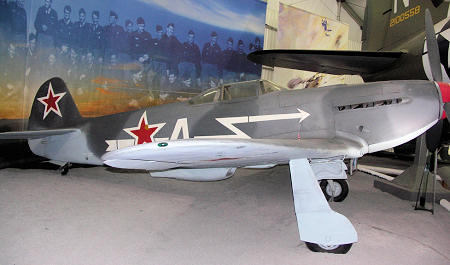 Yak-3,
Eduard 1/48 Profipack, Scott Van Aken review, Feb. 2007
Yak-3,
Eduard 1/48 Profipack, Scott Van Aken review, Feb. 2007November 2009
If you would like your product reviewed fairly and quickly, please contact me or see other details in the Note to Contributors.